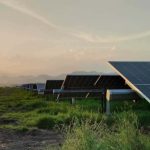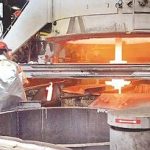More than 1 gigawatt of electricity has flowed into Oahu’s utility grid over the past week from a new solar farm in Ewa Beach.
Developers of the 42-megawatt Kupono Solar project held a ceremony Thursday recognizing the completion of the facility, which began commercial service June 7 and also has batteries capable of storing four days’ worth of electricity produced by the roughly 120,000 solar panels on 131 acres of land leased from the Navy.
Kupono is the biggest renewable energy project on Oahu to date with batteries, though other existing solar farms and one wind farm without batteries are bigger.
Some earlier Hawaii renewable energy projects have reduced the cost of electricity for consumers because the contracted price is less than the price for power made from burning imported oil. But the developer of Kupono, Ameresco Inc., is also being paid under its contract approved by the state Public Utilities Commission to help stabilize the grid with battery storage, so the project is expected to add about 30 cents to the monthly bill of a typical residential utility customer, or about 1% more.
The new source of electricity being fed to Hawaiian Electric’s grid will reduce pollution and help the utility company get closer to meeting a state goal to have 100% of all power come from renewable sources by 2045.
Kupono’s capacity is enough to power about 10,000 homes and increase the amount of renewable energy generation on Oahu by about 1 or 2 percentage points from 29.6% at the end of 2023.
“The 42 megawatts of energy these solar panels produce is small but is a significant part of the total electricity used here on Oahu on any given day,” Capt. Mark Sohaney, commander of Navy Joint Base Pearl Harbor-Hickam, said at the ceremony at the project site on the West Loch Annex of the base.
Nicole Bulgarino, executive vice president of
Massachusetts-based Ameresco, said the company is proud to finish its first of several planned renewable energy projects in Hawaii.
“At a time when it’s so needed to deliver this energy means a lot to us,” she said.
One of Ameresco’s future projects is a 99-
megawatt biofuel power plant called Puuloa Energy on the Pearl Harbor-Hickam base, slated for
delivery in 2027.
Shelee Kimura,
Hawaiian Electric president and CEO, welcomed Kupono to what she described as a growing
family or portfolio of renewable energy projects aimed at gradually displacing oil-fired power plants owned by the utility.
Kimura described Kupono as a huge milestone because of its size with batteries, though bigger solar farms with batteries are in the works on Oahu.
This pipeline includes a 52-megawatt project called Hoohana expected to come online in October, an 80-megawatt project called Makana La slated for 2027 and a 120-megawatt project called Mahi Solar also slated for 2027.
Hoohana and Mahi were previously delayed in part by supply chain problems during the coronavirus pandemic but have worked out difficulties and resolved contract issues with Hawaiian Electric.
Kupono Solar did not encounter such difficulties, though it has gone through some changes.
Initially, the project was a joint venture between Ameresco and Bright
Canyon Energy. Later, Ameresco acquired Bright Canyon. The project also was initially expected to cover 220 acres of Navy land that could have displaced 100 to 150 acres of farming by local food producer Larry Jefts, who had grown tomatoes and watermelons on the site.
Jason Smith, an Ameresco senior vice president, said the project’s footprint was adjusted so that it covered only about 40 acres of farmland. The balance of the site is previously vacant land that over years had attracted
illegal public dumping.
More than 20 tons of junk and 66 tons of scrap metal were removed from the site, including abandoned cars, boats, appliances, tires and construction waste, according to the company.
Ameresco also encountered several wild honeybee hives, which were temporarily relocated to a North Shore farm where a beekeeper produced honey with a Kupono Solar label. The more than 500,000 bees have been returned to another part of the Navy’s West Loch Annex near the solar farm.
Another benefit to local food production from the project will be grazing sheep on the property. Around a couple hundred sheep are on the site now to eat grass that grows around and under the panels, and more could be added depending on the pace of grazing, Smith said.
Meredith Berger, assistant secretary of the Navy, said a solar farm isn’t something people typically expect from the Navy, but resilient and reliable energy is a shared goal.
“We are charging towards those renewable energy goals,” she said. “We want to contribute to what Hawaii has set out, because it works for all of us. … We need to be able to keep
the lights on, keep the mission on, keep everything going, and it’s this type of energy that is going to be reliable.”
This post was originally published on 3rd party site mentioned in the title of this site





